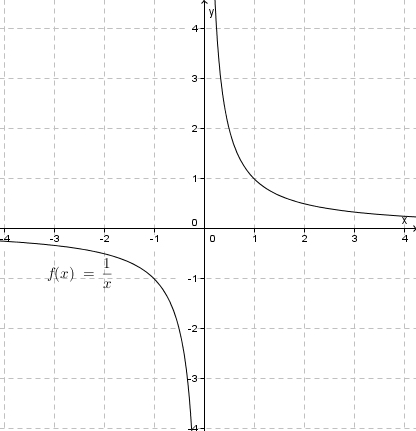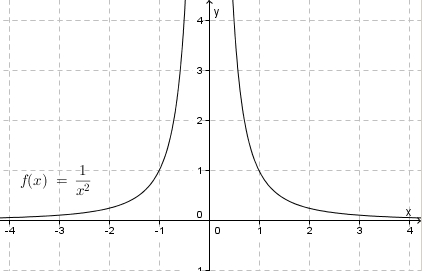Rationale Funktionen Polstellen: Unterschied zwischen den Versionen
| (3 dazwischenliegende Versionen von einem Benutzer werden nicht angezeigt) | |||
| Zeile 8: | Zeile 8: | ||
[[Rationale_Funktionen_Asymptoten|Asymptoten für x gegen unendlich]] | [[Rationale_Funktionen_Asymptoten|Asymptoten für x gegen unendlich]] | ||
---- | ---- | ||
| − | + | __NOCACHE__ | |
Die Funktion <math>f: x \rightarrow \frac{1}{x}</math> ist für <math> x = 0 </math> nicht definiert. Wie verhält sie sich in der Umgebung von <math>0</math>? Je kleiner <math>x</math> betragsmäßig wird, desto größer wird der Betrag von <math>\frac{1}{x}</math>. Zeigt eine Funktion für einen x-Wert ein solches Verhalten, dann ist der x-Wert eine Definitionslücke und man bezeichnet diese Stelle als Polstelle. | Die Funktion <math>f: x \rightarrow \frac{1}{x}</math> ist für <math> x = 0 </math> nicht definiert. Wie verhält sie sich in der Umgebung von <math>0</math>? Je kleiner <math>x</math> betragsmäßig wird, desto größer wird der Betrag von <math>\frac{1}{x}</math>. Zeigt eine Funktion für einen x-Wert ein solches Verhalten, dann ist der x-Wert eine Definitionslücke und man bezeichnet diese Stelle als Polstelle. | ||
| Zeile 20: | Zeile 20: | ||
1. Die Funktion <math>f: x \rightarrow \frac{1}{x}</math> hat für <math> x = 0 </math> einen Pol 1. Ordnung (<math>0</math> ist einfache Nullstelle des Nenners). | 1. Die Funktion <math>f: x \rightarrow \frac{1}{x}</math> hat für <math> x = 0 </math> einen Pol 1. Ordnung (<math>0</math> ist einfache Nullstelle des Nenners). | ||
| − | <center> | + | <center>[[Datei:Indirekte proportionalität.jpg]]</center> |
Nähert man sich von links an, also <math> x \rightarrow 0</math> mit <math>x<0</math>, dann streben die Funktionswerte nach <math>-\infty</math>; nähert man sich von rechts an, also <math> x \rightarrow 0</math> mit <math>x>0</math>, dann streben die Funktionswerte nach <math>\infty</math>. <math>f</math> hat an <math> x = 0</math> eine '''Polstelle mit Vorzeichenwechsel'''. Die Gerade <math>x = 0</math> ist senkrechte Asymptote des Graphen von <math>f</math>. | Nähert man sich von links an, also <math> x \rightarrow 0</math> mit <math>x<0</math>, dann streben die Funktionswerte nach <math>-\infty</math>; nähert man sich von rechts an, also <math> x \rightarrow 0</math> mit <math>x>0</math>, dann streben die Funktionswerte nach <math>\infty</math>. <math>f</math> hat an <math> x = 0</math> eine '''Polstelle mit Vorzeichenwechsel'''. Die Gerade <math>x = 0</math> ist senkrechte Asymptote des Graphen von <math>f</math>. | ||
2. Die Funktion <math>g: x \rightarrow \frac{1}{x^2}</math> hat für <math> x = 0 </math> einen Pol 2. Ordnung (<math>0</math> ist zweifache Nullstelle des Nenners). | 2. Die Funktion <math>g: x \rightarrow \frac{1}{x^2}</math> hat für <math> x = 0 </math> einen Pol 2. Ordnung (<math>0</math> ist zweifache Nullstelle des Nenners). | ||
| − | <center> | + | <center>[[Datei:1 durch x^2.jpg]]</center> |
Nähert man sich von links oder von rechts an, also <math> x \rightarrow 0</math> mit <math>x<0</math> oder <math>x>0</math>, dann streben die Funktionswerte in beiden Fällen nach <math>\infty</math>. <math>g</math> hat an <math> x = 0</math> eine '''Polstelle ohne Vorzeichenwechsel'''. Die Gerade <math>x = 0</math> ist senkrechte Asymptote des Graphen von <math>f</math>. | Nähert man sich von links oder von rechts an, also <math> x \rightarrow 0</math> mit <math>x<0</math> oder <math>x>0</math>, dann streben die Funktionswerte in beiden Fällen nach <math>\infty</math>. <math>g</math> hat an <math> x = 0</math> eine '''Polstelle ohne Vorzeichenwechsel'''. Die Gerade <math>x = 0</math> ist senkrechte Asymptote des Graphen von <math>f</math>. | ||
Aktuelle Version vom 21. September 2017, 13:49 Uhr
Einführung und Definition - Indirekte Proportionalität- Definitionsmenge - Nullstellen - hebbare Definitionslücken - Einfluss der Parameter - Polstellen - senkrechte Asymptoten - Asymptoten für x gegen unendlich
Die Funktion  ist für
ist für  nicht definiert. Wie verhält sie sich in der Umgebung von
nicht definiert. Wie verhält sie sich in der Umgebung von  ? Je kleiner
? Je kleiner  betragsmäßig wird, desto größer wird der Betrag von
betragsmäßig wird, desto größer wird der Betrag von  . Zeigt eine Funktion für einen x-Wert ein solches Verhalten, dann ist der x-Wert eine Definitionslücke und man bezeichnet diese Stelle als Polstelle.
. Zeigt eine Funktion für einen x-Wert ein solches Verhalten, dann ist der x-Wert eine Definitionslücke und man bezeichnet diese Stelle als Polstelle.
30px Merke
Ist an einer Definitionslücke
dann ist die Definitionslücke |
Beispiele:
1. Die Funktion  hat für
hat für  einen Pol 1. Ordnung (
einen Pol 1. Ordnung ( ist einfache Nullstelle des Nenners).
ist einfache Nullstelle des Nenners).

Nähert man sich von links an, also  mit
mit  , dann streben die Funktionswerte nach
, dann streben die Funktionswerte nach  ; nähert man sich von rechts an, also
; nähert man sich von rechts an, also  mit
mit  , dann streben die Funktionswerte nach
, dann streben die Funktionswerte nach  .
.  hat an
hat an  eine Polstelle mit Vorzeichenwechsel. Die Gerade
eine Polstelle mit Vorzeichenwechsel. Die Gerade  ist senkrechte Asymptote des Graphen von
ist senkrechte Asymptote des Graphen von  .
.
2. Die Funktion  hat für
hat für  einen Pol 2. Ordnung (
einen Pol 2. Ordnung ( ist zweifache Nullstelle des Nenners).
ist zweifache Nullstelle des Nenners).

Nähert man sich von links oder von rechts an, also  mit
mit  oder
oder  , dann streben die Funktionswerte in beiden Fällen nach
, dann streben die Funktionswerte in beiden Fällen nach  .
.  hat an
hat an  eine Polstelle ohne Vorzeichenwechsel. Die Gerade
eine Polstelle ohne Vorzeichenwechsel. Die Gerade  ist senkrechte Asymptote des Graphen von
ist senkrechte Asymptote des Graphen von  .
.
a) x = 2; Pol 1. Ordnung; Pol mit Vorzeichenwechsel; Annäherung von links (x<2):  ; Annäherung von rechts (x>2):
; Annäherung von rechts (x>2): 
b) x = 2; Pol 1. Ordnung; Pol mit Vorzeichenwechsel; Annäherung von links (x<2):  ; Annäherung von rechts (x>2):
; Annäherung von rechts (x>2): 
c) x = 2; Pol 2. Ordnung; Pol ohne Vorzeichenwechsel; Annäherung von links (x<2):  ; Annäherung von rechts (x>2):
; Annäherung von rechts (x>2): 
d) x = 3; Pol 7. Ordnung; Pol mit Vorzeichenwechsel; Annäherung von links (x<3):  ; Annäherung von rechts (x>3):
; Annäherung von rechts (x>3): 
e) x = -2; Pol 1. Ordnung; Pol mit Vorzeichenwechsel; Annäherung von links (x<-2):  ; Annäherung von rechts (x>-2):
; Annäherung von rechts (x>-2): 
- x = 3; Pol 1. Ordnung; Pol mit Vorzeichenwechsel; Annäherung von links (x<3):
 ; Annäherung von rechts (x>3):
; Annäherung von rechts (x>3): 
e) x = 0; Pol 1. Ordnung; Pol mit Vorzeichenwechsel; Annäherung von links (x<-2):  ; Annäherung von rechts (x>-2):
; Annäherung von rechts (x>-2): 
- x = 3; Pol 1. Ordnung; Pol mit Vorzeichenwechsel; Annäherung von links (x<3):
 ; Annäherung von rechts (x>3):
; Annäherung von rechts (x>3): 
 |

|
 |
keine Polstelle |
 |

|
 |

|
 |

|
 |

|
30px Merke
Man kann allgemein für eine gebrochen-rationale Funktion Ist n gerade, dann hat die Funktion Ist n ungerade, dann hat die Funktion Die Ordnung der Polstelle |
 einer gebrochen-rationalen Funktion
einer gebrochen-rationalen Funktion  ,
,


 mit
mit 
 mit
mit 
 mit
mit 
 mit
mit 
 richtig zu!
richtig zu!
 ändern. Beachte den Verlauf des Graphen bei geraden n und bei ungeraden n. Formuliere deine Beobachtung.
ändern. Beachte den Verlauf des Graphen bei geraden n und bei ungeraden n. Formuliere deine Beobachtung. formulieren:
formulieren:
 an der Stelle
an der Stelle  einen Pol ohne Vorzeichenwechsel.
einen Pol ohne Vorzeichenwechsel. 
